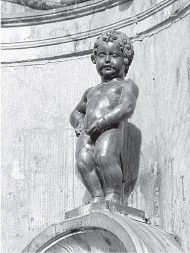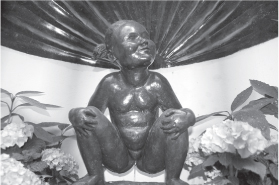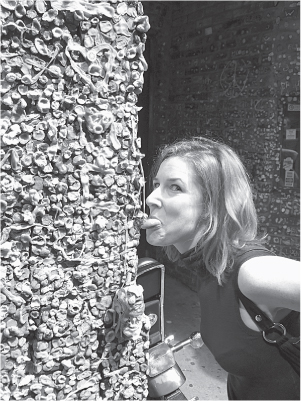Catherine Price (16 page)
Authors: 101 Places Not to See Before You Die

C
onsidering its name, any tourists who make a special trip to Brussels to see Manneken Pis have only themselves to blame. Yes, it’s weird that one of Brussels’ most famous attractions is a bronze sculpture of a naked boy urinating into a basin. But its name means “little pee man.” What exactly did you expect to see?
There’s nothing diminutive, however, about the statue’s popu-larity—it’s spawned an entire industry of Manneken-themed T-shirts and coffee mugs (I have a pencil sharpener), and has become an unofficial emblem of the city. It even has a fan club, the Friends of Manneken Pis, and a wardrobe: FOMP members have created more than eight hundred costumes for the boy. Depending on what day you show up, he might be dressed as anyone from Napoléon to Nelson Mandela; on truly special days, the Friends of Manneken Pis make the statue pee beer.
Accounts of the sculpture’s inspiration vary. Perhaps it is in honor of a two-year-old duke who, in 1142, was hung in a basket from a tree by his troops and then urinated on his army’s opponents. Perhaps it is a tribute to Juliaanske, a small boy from Brussels who is said to have saved the city walls from dynamite by peeing on a burning fuse. Or perhaps it’s simply in memory of a small boy gone missing, later found relieving himself in a garden. No one really knows.
Manneken Pis will likely fulfill most tourists’ quota for urinating statues. But if you still want more, check out his sister—her name is Jeanneke Pis, and she lives just up the street. Created in the mid-1980s by Denis-Adrien Debouvrie, the pig-tailed Jeanneke is cuter than her brother but no less naughty. Naked and smiling, she squats on top of a limestone pedestal and gazes blissfully toward the sky, as water drips from between her legs in a realistic tinkle.

Manneken Pis
Walter Vermeir/Wikipedia Commons

Jeanneke Pis
Wikipedia Commons
I
n the contentious world of international football, one of the oldest and most passionate rivalries is that between Scotland’s Celtic and Rangers football clubs. When the teams faced off in the first Old Firm derby—a game where the two teams go head-to-head—the press described the match as a “friendly encounter.” That hospitality, however, didn’t last long.
Part of the problem is the deep differences between Celtic and Rangers fans. Both teams are Scottish, but Celtic was founded in 1887 by a Catholic monk whose specific goal was to create a charity to help alleviate poverty in Glasgow’s Irish community. Rangers were the preferred team of the relatively comfortable Scottish Protestant majority; they didn’t even allow Catholics on the team till 1989. Adding to the conflict, Celtic fans tend to be Irish nationalists, whereas Rangers are unionists.
These differences can be explosive. On Old Firm weekends, admission rates for local hospitals increase ninefold, and the cumulative total for arrests at Old Firm derbies is the highest of any game in the world. After Celtic beat the Rangers 1–0 in the Scottish Cup Final at Hampden in 1980, more than nine thousand angry fans stormed the field in one of the largest on-field battles ever reported.
Which brings me to my point. Celtic’s color is green. Rangers’ is blue. If you don’t feel passionately about either side, you’d be wise to pick an outfit in a more neutral hue.
I
f evil were a plant, it would be poison oak. Prevalent up and down the United States’ Pacific coast, poison oak produces an oil called urushiol that causes a dermatologic version of hell—a weeping, itchy rash that can last for more than a month. About 85 percent of people are susceptible to urushiol, and as little as a billionth of a gram can cause a reaction, which means that a quarter of an ounce, judiciously applied, could cause a rash on every person on earth.
Given urushiol’s power, the idea of hosting a poison oak festival sounds stupid, if not sadistic. And yet every September for the past twenty-five years, the town of Columbia, California, has done exactly that. With categories based on a traditional flower show, it encourages people to bring in their finest specimens of poison oak to be judged in contests like Best Arrangement of Poison Oak, Best Poison Oak Accessory or Jewelry, and Most Potent Looking Red Leaves. There’s even a competition for the Best Photo of Poison Oak Rash and—I shudder to even mention this—the Most Original Poison Oak Dish.
Before you rush to enter, keep in mind that urushiol, being oil, doesn’t evaporate, so it can stay on your shoes or gloves or bouquet-making tools for years. If you accidentally burn the stuff, you can get a reaction in your lungs. Think you’re too smart to make that kind of mistake? Consider this: poison oak changes appearance depending on whether it’s in sun or shade—it can be a dense shrub or a climbing vine—so it’s not always easy to identify. Even worse, the plant doesn’t need its leaves to give you a rash: it has urushiol in its roots. If you’re unlucky enough to come in contact with any part of poison oak, your only hope is to slather yourself in Tecnu, a special cleanser whose original purpose gives a sense of how insidious urushiol is—Tecnu was originally designed to remove radiation fallout dust from skin.
T
here are two classes of coal mines in China—the large, state-run mines, which have suffocating bureaucracies and often don’t pay their workers, and the smaller, private ones, which put profit before safety and also often don’t pay their workers. Neither is good, especially since mining in China often requires working for up to seven days a week in sweltering tunnels that are constantly at risk of explosions, floods, or collapses. Unsurprisingly, accidents happen: according to the
Washington Post
, Chinese coal miners die at the rate of approximately one per hour, with more than seventeen miners killed for every million tons of coal produced—considerably higher than the American average of .05.
As an example of how bad things can get, consider the No. 5 Coal Mine in Gangzi. On July 22, 2001, during the tenth hour of their shift, ninety-two miners died when gases ignited in a poorly ventilated shaft. Why was it poorly ventilated? Because it didn’t have a ventilation system. Or, for that matter, a way to filter the coal dust from the air. It also had only one entrance, and its managers didn’t routinely check for dangerous gases (mines in the United States do so every twenty minutes).
A banner outside of the No. 5 Coal Mine proclaimed that
SAFETY IS HEAVEN
—but it’s unclear whether they meant that figuratively or literally. In either case, if you visit it or any of China’s other mines, be sure to pack a canary.
U
pon finishing a piece of chewing gum, the polite thing to do is to throw it out; not toss it on the ground or stick it on the bottom of a chair, but find a garbage can. In extreme situations, it is acceptable to swallow. But under no circumstances should you be allowed to take the moist, warm wad out of your mouth, stick it on a public wall, and call it art.
Think I’m being too strict? Check out Seattle’s gum wall. Tucked into an alley next to the Market Theater in Pike’s Place, it’s a brick wall covered with thousands upon thousands of wads of gum left there by people waiting in line. When the first masticated pieces arrived in the mid-1990s, the theater twice tried to remove them. But it was no use—the custom, as it were, stuck. The theater stopped fighting, and today, there are those who consider the wall an object of beauty.
I consider it disgusting. Some of the gum was originally used to affix coins to the wall—sort of a bastardized version of a wishing well—but this being Seattle, the money didn’t last long. Now there’s just gum, pounds of it, coating the wall in a layer so thick that in some places, you can no longer see any brick. There are sculptures of faces and dogs, initials surrounded by hearts, peace signs, and a multicolored American flag. One window drips with “gumsicles”; nearby, in a self-referential gesture, carefully shaped pieces of Wrigley’s spell out
GUM
.
The wall’s colorful, textured surface has made it popular with photographers. But even if you can’t see it, the wall is hard to miss—covered in more than a decade’s worth of Juicy Fruit, you can smell it from several feet away.

Kathleen Mikulis
I
t can be fun to escape real-world stress by jumping into a video game, but if you’re going to do so literally, make sure it’s not
MadWorld
, the ultraviolent adventure from Sega.
The game takes place in Varrigan City, a stylized, gritty dystopia where anyone you meet on the street is guaranteed to try to kill you. That’s because three days before the game begins, Varrigan City was targeted by a terrorist group called the Organizers, who cut off the city’s transportation and communication lines and unleashed a deadly virus that knocks out its victims in less than twenty-four hours after they catch it. The only way to survive is to kill another person—the Organizers promise a vaccine to anyone who commits murder.
In the true American spirit, the city’s reaction to the outbreak is not to notify the CDC, but instead to transform Varrigan City into the set for a recurring game show called
Death Watch
, in which characters fight for the ultimate prize—their lives. Occasionally these matches are supplemented by special Blood Bath Challenges, where contestants complete tasks not usually associated with vacation travel, like knocking people onto a dartboard with a giant bat or trapping them in front of oncoming trains.
If you go, keep in mind that you’ll be visiting as Jack Cayman, a character with a retractable chainsaw built into one arm. It’s a lucky accessory, given the context, but be sure to use it wisely—players are awarded points not just for kills, but for style. “The amount of points for killing foes increases by increasing the foe’s pain or using more unusual methods of killing,” explains one description of the game. “For example, while the player could impale an enemy on a wall of spikes, the player will earn significantly more points if they had previously forced a tire around the enemy or stuffed the enemy in a garbage can before impaling him.”
I know what you’re thinking: how should I pack? In addition to a tourniquet and a machete, make sure you bring aspirin—the roughly sketched characters and streetscapes in Varrigan City are rendered in a headache-inducing palette of black and white that’s only broken by the red of human blood.
